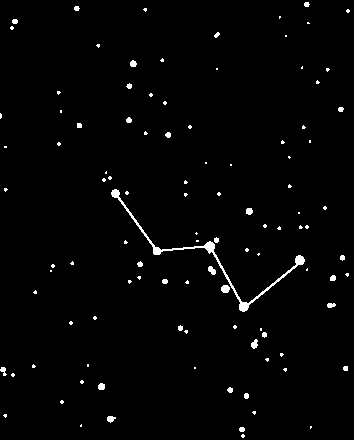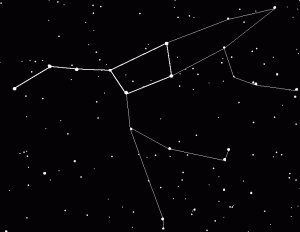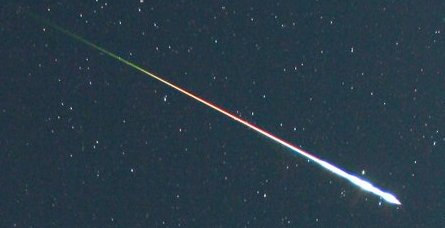Posts Tagged ‘satellites’
Lyrids Meteor Shower Watch #3
My final night trying to spot the Lyrids Meteor shower was a couple of nights ago, when it was at its peak. This time I did manage to see some meteors! Yay! But only three, which was a shame. I was outside for almost an hour as well, so I was expecting to see a few more to be honest with you.
The three I did see were pretty good though. The first one was really bright and quite big seeming, and it shot along the sky just under the shining Jupiter. It left a nice trail behind it, which lasted a couple of seconds, and the way it went just below Jupiter made it an awesome sight. The other two meteors were literally one after each other, with only about 1 second between them, if that. They were in a different area of the sky and were quite dull compared to the first one. But, as they whizzed past almost at the same time and in the same place, that made it really interesting for me. I had never seen two meteors in such close proximity like that before.
Other than the meteors, I managed to see ten satellites go over and 6 planes fly over Plymouth. I never knew there were so many planes flying over Plymouth each night! The satellites were mostly the usual bright spot, tracking along the sky, but this time I saw two of them basically following each other. It looked as though they were in the same orbit and travelling at the same speeds, which I hadn’t seen before. I found it quite interesting following them passing over our house.
So all in all, it wasn’t a good few days of meteor spotting. In fact, I usually see more meteors than I did, when there isn’t a meteor shower due! Hopefully, the skies will remain clear for the next meteor shower which will be the Eta Aquarids in early May, but this year isn’t going to be a good year to see them due to the size and brightness of the moon. Oh well!
Lyrids Meteor Shower Watch #2
Unfortunately, I again was unable to see any Lyrid Meteors last night, although I was only outside for about 20 minutes. I did manage to see 3 satellites and 2 planes in that time though, but there wasn’t a single meteor at all! It seems that when I go out purposefully trying to see meteors, I don’t see them, but when I go out just to have a general look at the sky, one or two always seem to shoot across the sky! 😉 Perhaps I will have better luck tonight as it is the height of the meteor shower today.
Perseids 2013
Last night I spent about 40 minutes outside meteor spotting. Luckily it was the first night in ages that there was a mostly clear sky, apart from the occasional wispy clouds that passed overhead. It was good timing as last night was the peak of the Perseid Meteor shower of 2013 although you can still see meteors up until the 24th August when the Earth passes out of the meteor hot spot.
It took a while to spot anything but in the end I managed to see 8 meteors, 4 satellites, the International Space Station (ISS – which was a nice surprise!) and a strange looking triangle shaped Plane with weird flashing lights (aliens? 😉 ). The most interesting thing of all was that I also saw a bright flash in the sky and then it gradually faded away. I think it must have been a larger meteor hitting the atmosphere and exploding or something but it seemed to be heading in the wrong direction for the meteor shower, which made it more strange. It would be interesting to know if anyone else saw this last night? It must have been about 23:20 when I saw this. Please leave a comment on this post if you did see that last night as well!
As mentioned above, if you missed the meteor show last night, then you can still see them up until near the end of the month. If you can find the constellations of Cassiopeia and The Plough (Ursa Major), then kind of look between and above them and this is the general area where the meteors shoot across the sky. There were some really good ones and a couple of years ago I saw the best meteor I have ever seen towards the end of August, so it is definitely possible to see them for a few weeks yet!
Asteroid 2012 DA14
On February 15th 2013, an Asteroid will be passing by Earth closer to us than the Moon is to our planet and closer to us than some satellites that we have orbiting us. There was a time when some scientists thought that the Asteroid would hit Earth, but they now believe it will miss us (thank goodness!), and will travel pass us at about 17,200 miles away. This is still pretty close and may possibly allow us, if it is a clear day and night, to view the Asteroid at some point. Those of us with access to good binoculars and telescopes should have a good view if the skies are clear.
To put the distance that Asteroid 2012 DA14 will swing by us in context, the Moon is 240,000 miles away and geosynchronous satellites are about 26,000 miles away. So the Asteroid will travel approx 9,000 miles closer to us than these satellites. The Asteroid itself is a small one compared to most others and is about 45m across with a mass of about 130,000 metric tons, but would still have caused some damage if it actually hit us!
NASA have released a statement regarding the Asteroid with a few more tidbits of information,
‘On [February 15, 2013], the asteroid will travel rapidly from the southern evening sky into the northern morning sky with its closest Earth approach occurring about 19:26 UTC when it will achieve a magnitude of less than seven, which is somewhat fainter than naked eye visibility. About 4 minutes after its Earth close approach, there is a good chance it will pass into the Earth’s shadow for about 18 minutes or so before reappearing from the eclipse. When traveling rapidly into the northern morning sky, 2012 DA14 will quickly fade in brightness.‘
The International Space Station and Perseid Meteors
During the month of August the ISS (International Space Station) could be seen in the sky during most evenings. The first time that I saw it was on Sunday 21st August when my family and I were on holiday in Weymouth. I wasn’t sure what to expect really as I didn’t know how bright it was going to be and how easily it could be made out from the rest of the stars in the sky. I had a NASA app on my phone which gave the general direction of where the ISS would be coming from and the length of time it would be viewable in the sky, but I was still worried that I wouldn’t see it.
Whilst on the look out, I was scanning the sky generally for constellations and satellites and to my amazement saw the best two shooting stars I had ever seen in my life. These were obviously not actual shooting stars but were two meteors from the Perseid Meteor Shower. This was especially great as the height of the meteor shower was a couple of weeks before, so these would have come from the tail end of the passing shower and were totally unexpected. They were so bright and the trails in the sky were long and wide. It was brilliant to see and completely lucky that I was looking at that area of the sky at the right time. I knew these were part of the Perseids as their general direction originated from towards the constellation Perseus, and from my position, they shot past in front of Cassiopeia as well.
The image below is the best image I can find that shows almost exactly what I saw in the sky.
Not long after, I suddenly spotted a very bright light in the sky coming from the direction where the ISS was meant to originate from. The object was moving as well which meant that what I was seeing was the ISS, and it was bang on time (the app gives the time of when the ISS becomes visible in the sky). Where I was watching was in the direct path of the ISS, so it flew directly over the top of me which was great to see! Looking at it you could just make out the solar panels and the general shape which made it an amazing sight. It lasted for about 4 minutes before it passed by and faded to black as it moved away from the sun (which was reflecting off the panels which is why it was visible in the sky). After seeing this, I was out most evenings when the sky was clear to view the International Space Station pass overhead, and I would recommend the viewing to anyone as it is a great thing to experience and puts a lot of things into perspective. Unfortunately, now we are in mid-September, the ISS has moved out of viewable range in the evenings although it can be seen for a fleeting moment during the early hours of the morning on occasions.
The sighting of the International Space Station also cleared up a little mystery from earlier in the year when I was out at Mount Batten in Plymouth and saw a very bright object move across the sky at a fairly brisk pace. At the time I wasn’t sure what it was and thought it may have actually been a UFO, but after seeing the ISS during the Summer, I can now say that what I saw in March was the ISS travelling across the sky above us. Am glad this has been cleared up although it would have been nice if it was a UFO! 😉



